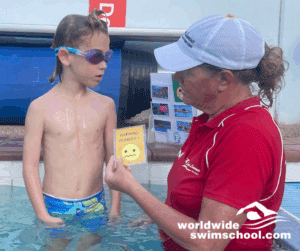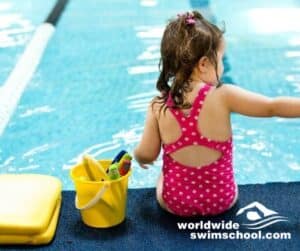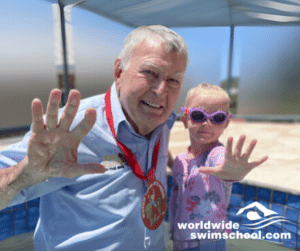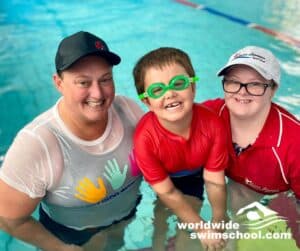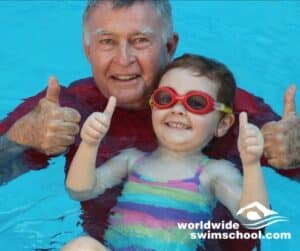To become happy and have water confidence, children need to be in control. For a 2 to 3 year old to truly be in control they require shallow water. This means utilising ledges, ramps, steps, even children’s play pools. It is silly to rush the process and expect children to be comfortable in deep water straight away. By giving children the opportunity to independently sit, play and explore in shallow water, we will not only leave them in control, but importantly we will teach them a respect for the water as they learn the difference between deep and shallow.
Enhance Children’s Learning
Enhance the learning experience and water confidence for your child by surrounding them with a variety of stimulus. This will make the lesson fun and interesting and will also relax your child as they become more familiar with their new playground – the watery environment. It’s important to remember that:
- Children need to be in control to feel safe and secure in the water
- Shallow water exploration not only puts children in control but teaches them a respect for the water as they learn the difference between deep and shallow
- Enhance the leaning experience by incorporating a variety of stimulus
Moving on to Deep Water Swimming
Once children are totally comfortable and have water confidence in the shallow end, then we can encourage them to experiment in the deep with parent or teacher. We do this by outstretching our arms and encouraging them to independently jump. Outstretching our arms allows the child to feel secure and again the child is in control because they initiate the jump.
It is important not to pick children up and force them off the ledge. If we do, then children lose control and can become intimidated and scared. It is also important that we do not move when we are encouraging children to jump. If we move then we lose the child’s trust. Losing trust can be extremely detrimental to the learn-to-swim process. Remember that:
- Children must be totally comfortable in shallow water before we take them into deep water
- Children must not be forced into deep water, they need to initiate jumping to an adult so they remain in control
- Allow children to feel secure by outstretching arms and maintain trust by not moving backwards
Cuddle Kicks
We can expand the deep water orientation through cuddle kicks. Cuddle kicks are great as children are nestled in close to the teacher or parent giving them that feeling of security. Children are also outstretched in the horizontal swimming position allowing them to feel the waters buoyancy. Furthermore adults have an opportunity to manipulate and encourage the correct kicking action.
Step to cuddle kick
1) Outstretch arms and encourage child to jump
2) Put child’s hands over your shoulders
3) Place hands under child’s knees
4) Place thumbs on back of child’s calf
5) Move legs up and down in the kicking action
6) Say kick kick kick
7) Walk backwards
Water Confidence Grows
As children’s confidence grows and they are happy with cuddle kicks and jumping to adults, you can teach them to jump to the ledge. Children usually feel much more comfortable jumping to the ledge because it is a solid object and the child knows it can not move. In the initial stages do not submerge the child. Simply place them over the ledge allowing them to pull themselves up.
Parents and teachers can now do repeated practice of jumping to adults, cuddle kicks and jumping back to the ledge. Children of this age thrive on repetition. It is great for their confidence because they know what’s coming and it’s great for their development as practice makes perfect.
Mastering the Skills
Parents and teachers should take this opportunity to use the teaching axiom show practice. On the way over we manipulate the legs showing the correct kicking action. On way back we keep the hands under the knees but let the child kick independently. This show practice and regular manipulation is vital for the correct mastery of this skill. Children who receive regular manipulation get certain nerves pathways formed that assist their fine motor co-ordination. This allows them to master the skill long before those who have not received this manipulation.
Relaxed in the Water
Remember the more children practice the more relaxed and comfortable they will become in the water. And once they are comfortable and relaxed, they will learn very very quickly. For this reason we must be mindful to go slow during the initial stages. Never force or hurry your child. This will only hinder the learn-to-swim process. Slow and steady will truly win the race with this age group. Remember that:
- Children are often more comfortable with jumping to the ledge because it is a solid object and children know it will not move
- Do not submerge child when jumping to the ledge
- Simply put them over the ledge and let them pull themselves up
- Participate in “show practice” as this will help in the mastery of swimming skills
- Remember slow and steady will win the race
Join our community to learn more and get access to our latest articles, content and more.
Parents and carers get some more information about how to teach your child at home.

